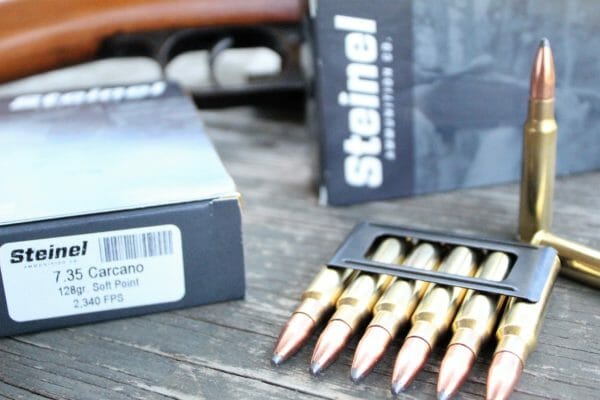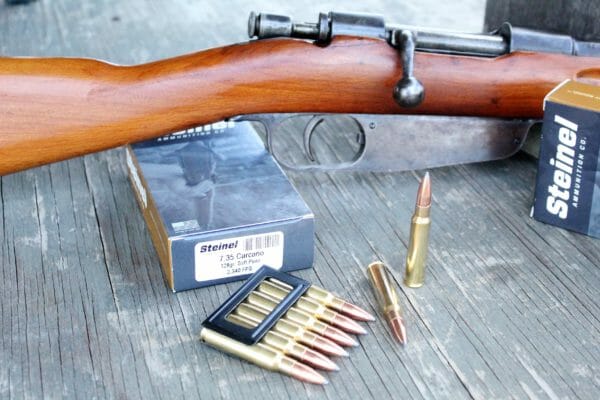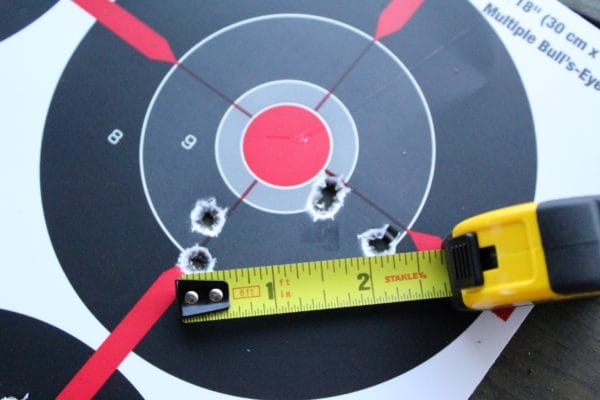Terril reviews the Steinel 7.35×51 Carcano Ammunition.
USA – -(AmmoLand.com)- The Italian Carcano series of long rifles and carbines have a reputation for being second-rate as military rifles and collectables, but to those of us who own and shoot them, they are a ton of fun with plenty of utility left in them. The rifles are cheap to buy and collect.
The same cannot be said for the ammunition. Finding 6.5×52 or 7.35×51 Carcano is a chore. The 6.5 round, originally chambered in the Carcano when it first debuted in 1891 up through World War II, and is available from few manufacturers today. The same cannot be said for the 7.35. The Italians attempted to switch over to this bigger-bore, intermediate-powered cartridge in 1938, but World War II started as the transition was underway and the project was discarded. Even with a short production time, there are thousands of Italian 7.35 rifles in circulation today all without a reliable supply of ammunition.
Surplus ammunition is collectable at this point. Occasionally PCI makes runs of the ammunition, but the quality levels on some of their ammo is hit and miss. I was cruising for other kinds of ammunition when I discovered, completely by accident, that Steinel Ammunition Company is producing the 7.35 Carcano cartridge as part of their Vintage line of rifle ammunition.
Steinel Ammunition produces rifle rounds from 223 Remington to 50 Beowulf and pistol rounds from 380 ACP to 500 Magnum. Their vintage line consists of 45-70 Trapdoor loads, 6.5 and 7.7 Arisaka, 30-06 M2 Ball, and lastly 7.35 unobtainium.
My 1939 produced Finnish-marked M38 rifle was begging for a range trip, so I got a few boxes and headed out to the range.
7.35×51 mm Carcano – The Loading

The 7.35×51 mm Carcano cartridge is a hard round to hand load for, let alone having someone produce factory ammunition for a niche market of crazy Carcano shooters like me. There are precious few components for the cartridge.
The 7.35×51 uses a .300″ diameter bullet, rather than a conventional .308″ found in other 30 caliber rounds like the 30-06, 30-30, ect. Using .308″ bullets could lead to over pressure and bad accuracy–perhaps even failure to chamber altogether. Cast bullets may work, if one could find a .301″ sizer to size down .308″ cast bullets, the only manufacturer of jacketed .300″ projectiles is a 128-grain flat-based soft-point spritzer bullet available from Hornady. Further, only PPU makes dedicated 7.35 brass. Needless to say, it was slim pickings when I bought my M38 and set out to do some hand loading. This round is a pain in the rear and I appreciate Steinel bringing it to market as loaded ammunition. Of course, they are using PPU brass and those Hornady .300″ soft-points.
The brass is brand-new and those Hornady bullets are crimped in solid. I felt bad taking what looks like excellent hunting ammo to the range for paper punching, but I got over it quickly.
I started out by shooting a few rounds through my chronograph. The 7.35×51 was developed to perform well out to three hundred meters in an era of one-thousand yard battle cartridges. Thus the bullet is light for caliber, 128 grains. The velocity is a little on the lighter end, though still nothing to sneeze at. Steinel advertises their ammunition at a velocity of 2,340 feet per second. My five-shot average was a little hotter, running out of my Carcano’s 21 inch barrel at 2,498 feet per second.
Even with this warmer load, felt kick-back was very little and the rifle barely moved off target from shot to shot.
With the numbers crunched, it was time to shoot for groups.

7.35×51 mm Carcano – Downrange
These M38 Carcanos, like many old military rifles, are tricky to shoot with our modern conception of sights. We are used to iron sights that you hold directly where you want the bullet to go. But like other rifles of its time, the M38 shoots high at short distances. The sight picture on the Carcano is a little bit different, as well. For targets 100 yards and in, bury the front blade sight deep into the V-notch rear. That seems counterintuitive, given we are used to lining up front and rear sight evenly.
Even with this trick, I had to hold a foot low in order to hit paper at fifty yards. Did I mention I haven’t shot this rifle in over a year.
It is as if the Italians wanted you to see your target–rather than have it covered by the sights…
People complain about the sights, the draggy action, problematic clips, and wild inaccuracy of the Carcano rifle. What I can say is that these rifles are not inaccurate. My first six rounds struck into a respectable four-inch group, given one low flyer. I found my point of aim, so I loaded up another clip and tried again at fifty, and further out to one hundred yards.
Again, granting one flyer, I was able to cluster my rounds into a two-inch group at fifty yards. At one hundred yards, I was favoring high on target but still able to put the rounds into a four to six inch cluster. I wager that has more to do with my having to aim at the foot of the target, than having a dedicated aiming point.

7.35×51 mm Carcano – The Bottom Line
The Carcano family of rifles occupies a hazy middle ground in nineteenth and early twentieth century firearms development. Forward-thinking, yet economical. Well-engineered, yet unrefined. Carried by a nation on the cusp of being a world power to one complicit with evil. One might call it the hipster gun of milsurps. Not that cool Mauser, but not that tacky Mosin. No matter my mental gymnastics, I think the best story a gun can tell is how well it shoots. Steinel’s 7.35×51 ammo is high-quality, good shooting, and it won’t leave a huge-caliber hole in your wallet. While you might not be taking that old Italian rifle into the deer woods this winter, you have another option to make that gun talk.
About Terril Hebert:
Terril Hebert is a firearm writer native to south Louisiana. Under his motto-Guns, Never Politics-he tackles firearm and reloading topics both in print and on his Mark3smle YouTube channel, where he got his start. Terril has a soft spot for ballistics testing, pocket pistols, and French rifles. When he is not burning ammo, he is indulging his unhealthy wildlife photography obsession or working on his latest novel. Scourge of God, published in 2017. See more from Terril on youtube under Mark3smle
